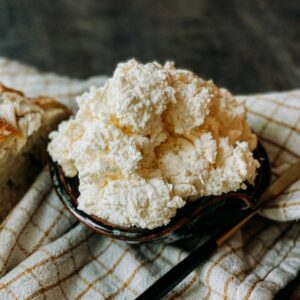
Homemade Cream Cheese
Delicious tangy homemade cream cheese made with simple ingredients.
Equipment
- heavy bottom cooking pot to warm and curdle milk
- organic cheese cloth to tie up curds in for straining
- large bowl to catch whey as it drips
- colander or strainer to hold curds as it drains
- cooking thermometer to measure temperature at 86 degrees Fahrenheit
- air tight container for storage
Ingredients
- 1-4 quarts whole milk or cream
- 1 packet cream cheese starter culture
- kosher salt to taste
Instructions
- Heat the milk, slowly, to 86°F on the lowest possible setting.
- Remove the milk from the heat and stir in the packet of cream cheese culture mixture with an up and down motion, not round and round. [Do not stir longer than 15 seconds.]
- Cover the pot and leave the mixture to culture at room temperature for 12 hours (about 72° - 77°F.)
- After 12 hours, your milk will curdle. Remove the lid and you’ll see the cheese is fairly solid but still relatively soft and resembles yogurt. This is normal and is what makes milk become cream cheese. The whey (clear or cloudy liquid) is separating from the cheese. (Save the whey for other uses if you like. *see below)
- Next, drape a piece of doubled muslin in the colander set over a bowl. (I clip the edges of muslin to the bowl to hold it in place.) Carefully pour or spoon the cultured milk into the prepared container.
- Gather up the corners of the muslin, use cotton string to tie these together, then hang from a hook or knob, allowing the whey to drip into a clean large bowl (you can use the leftover whey, too!)
- After 6-12 hours, the cream cheese will reach a thicker consistency. (The longer you allow it to drain the more it will thicken.)
- Salt the cream cheese and store in an airtight container.
Video
Notes
What to do with leftover whey:
- feed some of it to farm animals or pets
- use it in the place of broth
- add it to mashed potatoes (or cauliflower)
- use it instead of water when baking bread
- dilute it and use it to water plants
Tried this recipe?Let us know how it was!